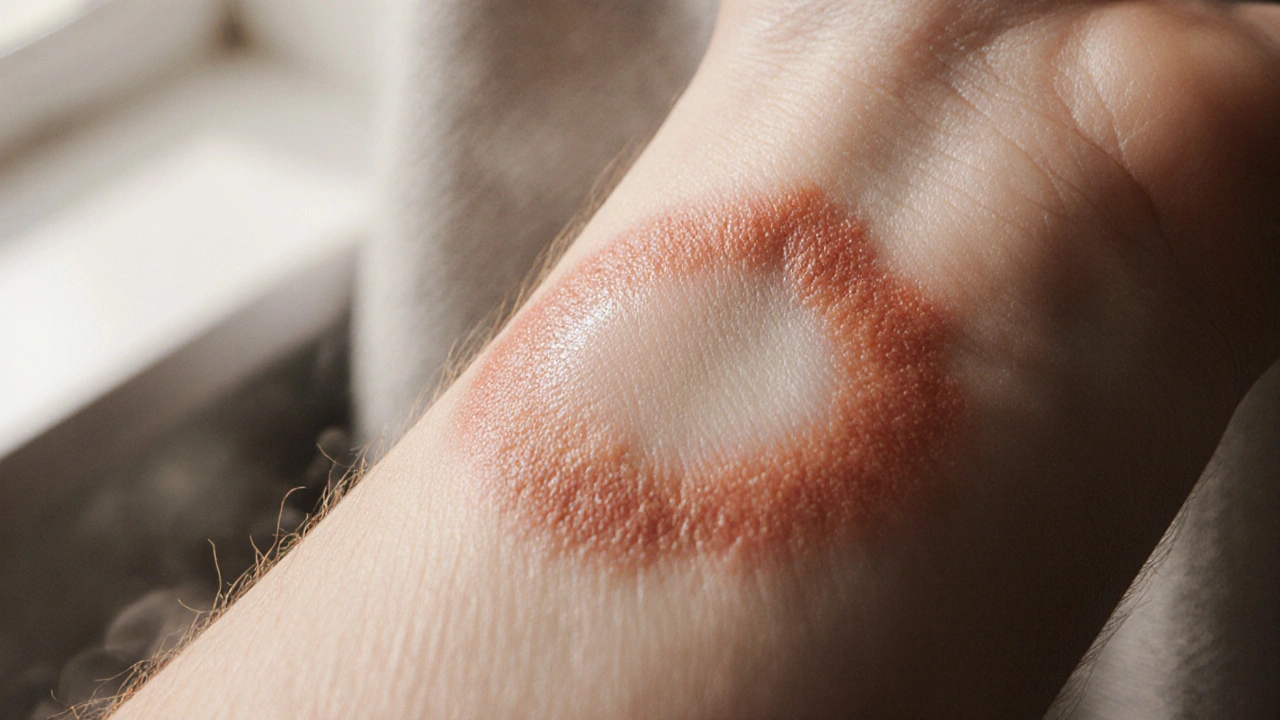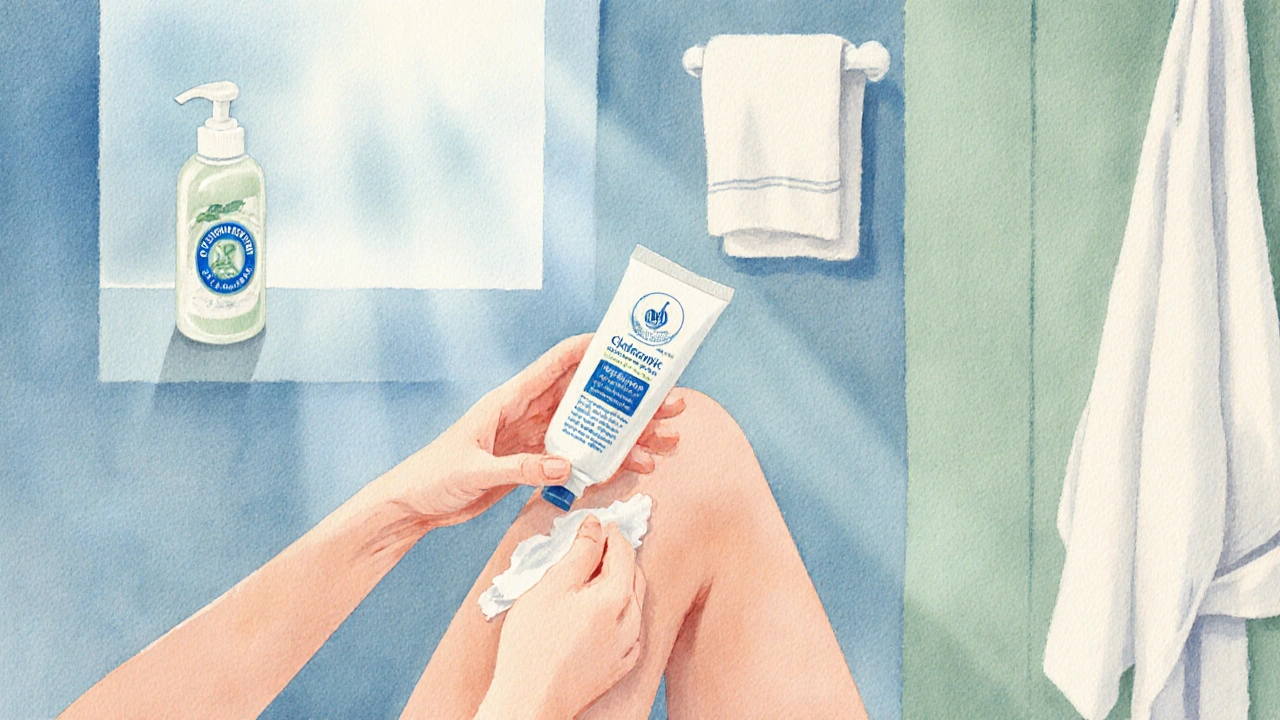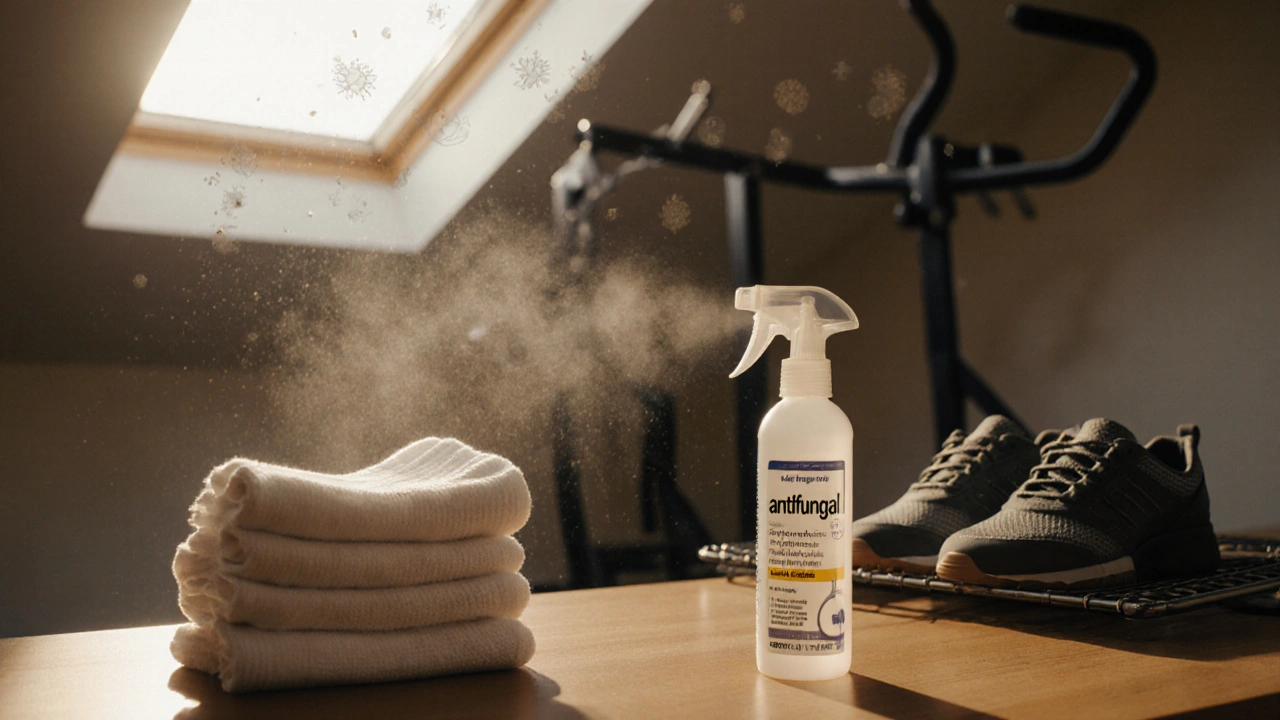Treating Fungal Skin Irritations: Effective Home and Medical Solutions

When dealing with fungal skin infection is a condition where fungi invade the outer layer of the skin, causing irritation, redness, and itching, prompt action can stop the spread and ease discomfort. This guide walks you through what causes these irritations, how to recognize them, and the most reliable ways to treat fungal skin irritation at home or with a doctor’s help.
Key Takeaways
- Identify the type of fungus (dermatophyte vs. Candida) to choose the right treatment.
- Topical antifungals work for most localized infections; oral meds are needed for extensive or deep infections.
- Keeping skin dry, clean, and breathable is the single most effective preventive step.
- Watch for red‑flag signs - spreading rash, fever, or no improvement after two weeks - and see a clinician.
- Home remedies can complement, but not replace, proven medical therapies.
Understanding Fungal Skin Irritations
Fungi that love warm, moist environments thrive on our skin. The most common culprits belong to two groups:
- Dermatophytes are mold‑like organisms that feed on keratin, the protein in skin, hair, and nails. They cause ringworm (tinea) and athlete’s foot.
- Candida species are yeasts that often colonize folds, groins, and under‑breasts, leading to candidiasis.
Both groups produce irritation by damaging skin cells and triggering an immune response. The result is redness, scaling, and an urge to scratch - which can further spread the fungus.
Spotting the Symptoms
Early detection saves a lot of hassle. Look for these tell‑tale signs:
- Circular, red patches with clearer centers - classic tinea corporis.
- Itchy, white‑to‑cream patches in warm folds - typical Candida.
- Peeling or cracking skin between toes or on soles - athlete’s foot.
- Water‑soaked, sticky feeling that gets worse after sweating.
If the rash spreads rapidly, forms blisters, or is accompanied by fever, it’s time to get professional care.
Immediate First‑Aid Steps
Before grabbing medication, put the fungus on the back foot:
- Gently wash the affected area with lukewarm water and a mild, fragrance‑free soap.
- Pat dry with a clean towel - do not rub, as friction can break skin.
- Apply a thin layer of an over‑the‑counter antifungal cream (e.g., clotrimazole 1% or terbinafine 1%) to the clean skin.
- Leave the area uncovered if possible; wear breathable cotton clothing.
- Repeat twice daily for at least two weeks, even if symptoms fade.
These steps curb the fungus’s growth while you arrange a more thorough treatment plan.
Topical Antifungal Options
Topical agents are the first line for most localized infections. Here’s a quick look at the most used creams and sprays:
- Clotrimazole 1% - broad‑spectrum, works well for tinea and candidiasis.
- Terbinafine 1% - especially effective against dermatophytes, often clears rash in 7‑10 days.
- Miconazole nitrate - good for moist areas, also available as powder for foot infections.
Apply a thin film to the lesion and a 2‑cm margin around it. If the product comes with a spray, use it after drying the skin to reach folds.

When Oral Antifungals Are Needed
Some infections ignore creams. Deep nail infections, widespread body rashes, or cases that relapse after topical therapy require systemic treatment. Common oral options include:
- Fluconazole - a once‑daily pill that concentrates in skin and nails.
- Itraconazole - good for stubborn tinea corporis and chronic candidiasis.
- Griseofulvin - an older drug still used for extensive dermatophyte infections.
These medications are prescription‑only because they can interact with other drugs and affect liver function. A doctor will order blood tests to monitor safety.
Comparison: Topical vs. Oral Antifungals
| Aspect | Topical Cream/Spray | Oral Medication |
|---|---|---|
| Typical Use | Localized rash, foot infection, mild candidiasis | Widespread rash, nail involvement, recurrent infections |
| Duration | 2-4 weeks | 1-6 weeks (often longer for nails) |
| Effectiveness | 70‑90% cure rate for simple cases | 90‑95% cure rate for complex cases |
| Side Effects | Local irritation, rare allergic reactions | GI upset, liver enzyme elevation, drug interactions |
| Cost | Low - over‑the‑counter | Higher - prescription, possible lab monitoring |
Home Care Tips to Speed Recovery
Medical treatment works best when you control the environment that feeds the fungus. Adopt these habits:
- Moisture control - towel dry thoroughly, especially between toes, and change socks at least once daily.
- Hygiene routine - shower after sweating, use a separate washcloth for infected areas.
- Wear breathable fabrics - cotton underwear, loose‑fit shoes with ventilation.
- Disinfect shared surfaces - shower floors, gym equipment, and towels with diluted bleach (1part bleach to 10parts water).
- Boost immune system health - balanced diet, adequate sleep, and managing stress.
These steps don’t replace medication but dramatically lower the chance of recurrence.
When to Seek Professional Help
If any of the following occurs, book an appointment promptly:
- Rash spreads beyond the original area or forms new patches.
- Symptoms persist beyond two weeks despite proper topical use.
- Severe pain, swelling, or oozing fluid appears.
- Fever, chills, or feeling generally unwell.
- You have diabetes, compromised immunity, or are pregnant - these conditions alter treatment choices.
A clinician can confirm the fungal species with a skin scrape, prescribe the right oral drug, and monitor for side effects.
Quick Treatment Checklist
- Confirm the type of fungus (dermatophyte vs. Candida).
- Clean and dry the affected skin.
- Apply an appropriate over‑the‑counter antifungal cream twice daily.
- Maintain a dry, breathable environment for at least 14 days.
- Re‑evaluate after 7‑10 days - if no improvement, see a doctor.
- Consider oral therapy only under medical supervision.
- Practice preventive hygiene to avoid reinfection.

Frequently Asked Questions
Can I use coconut oil to cure a fungal skin infection?
Coconut oil has mild antifungal properties, but scientific evidence shows it’s not strong enough to clear a full‑blown infection on its own. It can be used as a supportive moisturizer after applying a proven antifungal cream, not as a substitute.
How long does it take for a topical cream to work?
Most people see noticeable relief within 3‑5 days, but the full cure usually requires 2‑4 weeks of consistent use, even if the rash looks better earlier.
Is it safe to share towels when someone has a fungal rash?
No. Fungi spread easily via damp fabric. Use separate towels, wash them in hot water (≥60°C), and dry thoroughly before reuse.
Do antifungal creams work on nail fungus?
Topical treatments have limited penetration into the nail plate. For lasting nail infections, oral antifungals or prescription nail lacquers are usually required.
Can I continue exercising while treating athlete’s foot?
Yes, but wear moisture‑wicking socks, change them after each session, and apply antifungal spray to your feet before and after workouts to keep the fungus from thriving.
Leon Wood
October 4, 2025 AT 03:10Got a fungal rash? Don't panic-start with the basics.
Wash, dry, and slap on a thin layer of clotrimazole, twice a day, and stay consistent for at least two weeks.
Keep your skin breathing and your socks dry, and you'll see the itch fade fast.
Remember, consistency beats a quick fix every time!
George Embaid
October 4, 2025 AT 04:06Different cultures have their own home‑remedies, but pair them with proven antifungals for best results.
Always test a small area first to avoid irritation.
Meg Mackenzie
October 4, 2025 AT 05:30Ever wonder why the same OTC creams keep popping up on pharmacy shelves?
It's because big pharma wants you to stay dependent on cheap repeats while the real cure is hidden.
They don’t want you drying out the fungus with simple hygiene because that cuts their profit line.
Keep an eye on the ingredient list-some "natural" additives are just placebos.
Trust your gut, not the marketing hype.
Barry White Jr
October 4, 2025 AT 06:20Dry your feet thoroughly; moisture loves fungus.
Henry Kim
October 4, 2025 AT 07:26Your step‑by‑step routine is spot on; I’d add that changing into fresh cotton socks after any sweating session cuts the moisture cycle dramatically.
Also, a quick spray of terbinafine on the toe webs before bed can boost the topical effect.
Consistency really does the trick.
Neha Bharti
October 4, 2025 AT 08:33Balance your diet, sleep well, and the immune system will help keep fungal overgrowth at bay.
Samantha Patrick
October 4, 2025 AT 09:40u r right bout the hype-coconut oil ain’t a magic bullet, but a lil dab after your cream can keep skin from cracking.
Just don’t skip the proven meds.
Ryan Wilson
October 4, 2025 AT 11:03It’s funny how many ignore basic hygiene while preaching ‘advanced’ treatments; maybe if we all just washed our hands and feet properly, we wouldn’t need all these fancy prescriptions.
Look, the answer isn’t a conspiracy, it’s simple diligence.
EDDY RODRIGUEZ
October 4, 2025 AT 12:26Listen up, warriors against itch! The battlefield is your skin, and the weapons are clotrimazole, breathable cotton, and relentless consistency.
Attack the fungus twice daily, keep the area dry, and don’t surrender to temptation of scratching.
Victory comes to those who stay the course!
Christopher Pichler
October 4, 2025 AT 13:50Sure, EDDY, because treating a dermatophyte is basically a combat simulation-complete with tactical redeployment of topical agents and moisture‑control logistics.
Meanwhile, the average patient just wants a simple solution, not a NATO‑style briefing.
VARUN ELATTUVALAPPIL
October 4, 2025 AT 15:13Exactly!!! If you think the ‘battlefield’ analogy is over‑the‑top, just remember that fungal spores proliferate at a rate of approximately 10⁶ per cm² per hour-an exponential growth curve that is best visualized with a logarithmic scale!!!
Dalton Hackett
October 4, 2025 AT 16:36When you first notice a red, scaly patch on your skin, the temptation is often to ignore it, assuming it will resolve on its own.
However, fungal organisms thrive in warm, moist environments and can rapidly expand beyond the initial site if left unchecked.
The first line of defense, as most dermatologists will attest, is thorough cleansing with a mild, fragrance‑free soap to remove surface debris.
Following the wash, patting the area dry with a clean towel-never rubbing-prevents micro‑abrasions that could serve as entry points for deeper infection.
Application of an over‑the‑counter antifungal cream such as clotrimazole or terbinafine should be done in a thin film, extending a centimeter beyond the visible margin of the lesion.
It is crucial to maintain this regimen twice daily, typically in the morning and before bedtime, for a minimum of two weeks, even if symptoms appear to improve sooner.
Neglecting the full course often results in a rebound effect, where the fungus reestablishes itself, sometimes with increased resistance to the same medication.
In addition to topical therapy, environmental control plays a pivotal role; swapping out synthetic fabrics for breathable cotton reduces humidity on the skin surface.
Changing socks and underwear daily, especially after exercise or perspiration, cuts down the moisture reservoir that fungi love.
Disinfecting shared surfaces-gym mats, shower floors, and towels-with a diluted bleach solution (one part bleach to ten parts water) can interrupt transmission pathways.
For those with underlying conditions such as diabetes or immunosuppression, oral antifungal agents like fluconazole may become necessary, but these require physician oversight due to potential hepatic side effects.
Regular monitoring of liver function tests during systemic therapy helps catch adverse reactions early, safeguarding patient health.
If after a full two‑week course of topical treatment there is no appreciable improvement, it is advisable to seek professional evaluation for possible culture and sensitivity testing.
Such testing can identify the exact fungal species, guiding the selection of the most effective medication, whether topical or oral.
In summary, a disciplined approach combining proper hygiene, consistent medication use, and environmental modifications offers the highest likelihood of a swift and complete recovery.
William Lawrence
October 4, 2025 AT 18:00Wow, a 15‑sentence lecture for a simple rash-who needs that many words when a quick dip in the tub does the job.